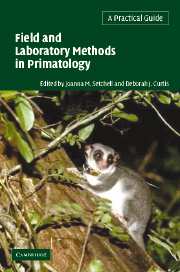Book contents
- Frontmatter
- Contents
- List of contributors
- Forword by Robert D. Martin
- Introduction
- 1 Human-nonhuman primate interactions: an ethnoprimatological approach
- 2 Habituating primates: processes, techniques, variables and ethics
- 3 Habitat description and phenology
- 4 The Global Positioning System, Geographical Information Systems and Remote Sensing
- 5 Monitoring local weather and climate
- 6 Survey and census methods: population distribution and density
- 7 Trapping primates
- 8 Handling, anaesthesia, health evaluation and biological sampling
- 9 Morphology, morphometrics and taxonomy
- 10 Marking and radio-tracking primates
- 11 Feeding ecology and seed dispersal
- 12 Dietary analysis I: Food physics
- 13 Dietary analysis II: Food chemistry
- 14 Collecting arthropods and arthropod remains for primate studies
- 15 Tape-recording primate vocalisations
- 16 Photography and video for field researchers
- 17 Chronobiological aspects of primate research
- 18 Thermoregulation and energetics
- 19 Field endocrinology: monitoring hormonal changes in free-ranging primates
- 20 Collection, storage and analysis of non-invasive genetic material in primate biology
- 21 Tips from the bush: an A-Z of suggestions for successful fieldwork
- Index
- References
Introduction
Published online by Cambridge University Press: 05 June 2012
- Frontmatter
- Contents
- List of contributors
- Forword by Robert D. Martin
- Introduction
- 1 Human-nonhuman primate interactions: an ethnoprimatological approach
- 2 Habituating primates: processes, techniques, variables and ethics
- 3 Habitat description and phenology
- 4 The Global Positioning System, Geographical Information Systems and Remote Sensing
- 5 Monitoring local weather and climate
- 6 Survey and census methods: population distribution and density
- 7 Trapping primates
- 8 Handling, anaesthesia, health evaluation and biological sampling
- 9 Morphology, morphometrics and taxonomy
- 10 Marking and radio-tracking primates
- 11 Feeding ecology and seed dispersal
- 12 Dietary analysis I: Food physics
- 13 Dietary analysis II: Food chemistry
- 14 Collecting arthropods and arthropod remains for primate studies
- 15 Tape-recording primate vocalisations
- 16 Photography and video for field researchers
- 17 Chronobiological aspects of primate research
- 18 Thermoregulation and energetics
- 19 Field endocrinology: monitoring hormonal changes in free-ranging primates
- 20 Collection, storage and analysis of non-invasive genetic material in primate biology
- 21 Tips from the bush: an A-Z of suggestions for successful fieldwork
- Index
- References
Summary
The ideal program for the future study of animal behaviour would involve the coordination of field and laboratory investigation.
Schaller (1965, p. 624)In the early days of expeditions, a naturalist's field equipment consisted of little more than a gun, the means to preserve specimens, and luggage bearers. Later on, field primatologists relied on pencil and paper, binoculars, a compass and, if they were studying nocturnal species, a torch. More recently, a shift in emphasis towards integration of methods has led to collaboration between laboratory and field researchers working on wild primates. Technological advances have presented fieldworkers with the opportunity to collect more sophisticated data, store samples for later laboratory analysis, analyse samples in the field and collect information remotely. This has led to an increase in data concerning (for example): population and group structure; growth, development and physiology; and the application of non-invasive techniques for DNA analyses and hormonal assays. Ecological methods and techniques available for monitoring primate habitats have also improved, with the application of remote sensing, mapping (Global Positioning System, GPS), and data integration (Geographical Information Systems, GIS). These methods open up possibilities for collecting new information on previously studied populations, and a means for collecting data on species that, for example, cannot be habituated for behavioural observations. However, these technological advances come at a time when 64% of primate species are under threat and insufficient data are available to assess the status of a further 11% of species (2000 IUCN Redlist of threatened species).
Information
- Type
- Chapter
- Information
- Field and Laboratory Methods in PrimatologyA Practical Guide, pp. 1 - 14Publisher: Cambridge University PressPrint publication year: 2003
